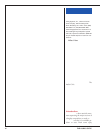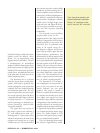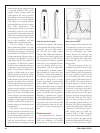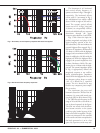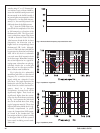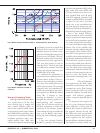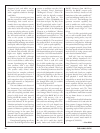
ISSUE NO. 28 • SUMMER/FALL 2002 21
Use and Listening Tests
Although each Infinity Intermezzo
4.1t is quite heavy at 93 lbs., they
were relatively easy to unpack and
move around. Without spikes at-
tached, they could be walked ar
ound
on my listening room’s carpet without
much difficulty for positioning. O
nce
set up
, the 4.1t
’
s pr
esented a strikingly
handsome appearance with a thor-
oughly modern look.
W
ith their
curved and sculptured metallic design
and Infinity’s attention to detail, they
definitely did not present the usual
mundane picture of wooden rectan-
gular boxes. With grilles removed, the
picture was no less likable. The side-
mounted woofers had a heavy-duty,
no-nonsense look that urged me to
“let’s turn these babies on and see
what they’ll do.” The low end of the
4.1t’s did not let me down. It was like
having a pair of good subwoofers, one
on both sides of my room!
I evaluated the Intermezzos as
two-channel stereo speakers and not
as home theater systems. Their per-
formance was outstanding in almost
every area. They would perform very
w
ell in either situation.
They str
ongly
competed with, and sometimes ex-
ceeded, the per
formance of my r
efer
-
ence speakers, the B&W 801 Matrix
Series III’s. I listened to them
standing by themselves as well as
alongside the reference speakers in a
rapid-switching A/B comparison
setup. The 4.1t’s did not require any
line-level attenuation to match the
sensitivity of the reference systems.
Their v
olume lev
el was essentially the
same as of the B&W’s when repro-
ducing the same br
oadband pr
ogram
material.
I first went through Infinity’s
R.A.B.O.S. pr
ocedur
e of setting the
bass lev
el and equalization (EQ), using
their sound level meter (SLM) and
CD. M
y intentions were first to use
their supplied SLM and CD along
with their suggested pr
ocedure long
enough to gain familiarity with them
to report in this review, and then
switch over to my one-third-octave
real-time spectrum analyzer (an Au-
dioControl Industrial SA-3050A) to
finish the EQ and level-setting process.
But—I was fooled! Infinity’s
method worked so well I continued
using it to measure the room response
and set the built-in parametric equal-
izer. I only used the real-time analyzer
to set the overall bass-to-upper-range
balance. Part of the problem with
using the real-time analyzer and pink
noise (played off the Infinity CD or
the built-in noise generator) was the
variability of the band readings due to
the inherent randomness of the noise.
The R.A.B.O.S. system, in contrast,
uses sine wave warble tones, which in-
herently exhibit much less level varia-
tion. The warble tones, interestingly,
worked better with the real-time ana-
lyzer but of course energized only one
band at a time. The warble tones
sounded like something from a ’50s
sci-fi movie,
The War of the Worlds or
Forbidden Planet! The sci-fi ambience
was reinforced by the SLM, which
looked like a cr
oss betw
een a S
tar Trek
communicator and a Flash Gordon
blaster
. S
etting the width or Q of the
parametric equalizer was made much
simpler with Infinity’s graphical
scheme, using the adjustable plastic
gizmo.
The measured bass response of
the 4.1t’s in my basement listening
room exhibited a broad peak of
about 8 dB at 26 Hz as referenced to
the
response between 60 and 100
Hz.
When
the peak was equalized
with the Intermezzo’s built-in para-
metric
equaliz
er
,
the bass response
was much flatter and better behaved.
The equalizer’s controls, which vary
Fig. 7: Woofer harmonic distortion (THD) vs. fundamental level, 20 Hz to 80 Hz.
Fig. 8: Woofer maximum peak SPL vs.
fr
equency
.



